Statistical models in medical image analysis
Author(s)
Leventon, Michael Emmanuel
DownloadFull printable version (28.29Mb)
Other Contributors
Massachusetts Institute of Technology. Dept. of Electrical Engineering and Computer Science.
Advisor
W. Eric L. Grimson.
Terms of use
Metadata
Show full item recordAbstract
Computational tools for medical image analysis help clinicians diagnose, treat, monitor changes, and plan and execute procedures more safely and effectively. Two fundamental problems in analyzing medical imagery are registration, which brings two or more datasets into correspondence, and segmentation, which localizes the anatomical structures in an image. The noise and artifacts present in the scans, combined with the complexity and variability of patient anatomy, limit the effectiveness of simple image processing routines. Statistical models provide application-specific context to the problem by incorporating information derived from a training set consisting of instances of the problem along with the solution. In this thesis, we explore the benefits of statistical models for medical image registration and segmentation. We present a technique for computing the rigid registration of pairs of medical images of the same patient. The method models the expected joint intensity distribution of two images when correctly aligned. The registration of a novel set of images is performed by maximizing the log likelihood of the transformation, given the joint intensity model. Results aligning SPGR and dual-echo magnetic resonance scans demonstrate sub-voxel accuracy and large region of convergence. A novel segmentation method is presented that incorporates prior statistical models of intensity, local curvature, and global shape to direct the segmentation toward a likely outcome. Existing segmentation algorithms generally fit into one of the following three categories: boundary localization, voxel classification, and atlas matching, each with different strengths and weaknesses. Our algorithm unifies these approaches. A higher dimensional surface is evolved based on local and global priors such that the zero level set converges on the object boundary. Results segmenting images of the corpus callosum, knee, and spine illustrate the strength and diversity of this approach.
Description
Thesis (Ph.D.)--Massachusetts Institute of Technology, Dept. of Electrical Engineering and Computer Science, 2000. Includes bibliographical references (leaves 149-156).
Date issued
2000Department
Massachusetts Institute of Technology. Department of Electrical Engineering and Computer SciencePublisher
Massachusetts Institute of Technology
Keywords
Electrical Engineering and Computer Science.